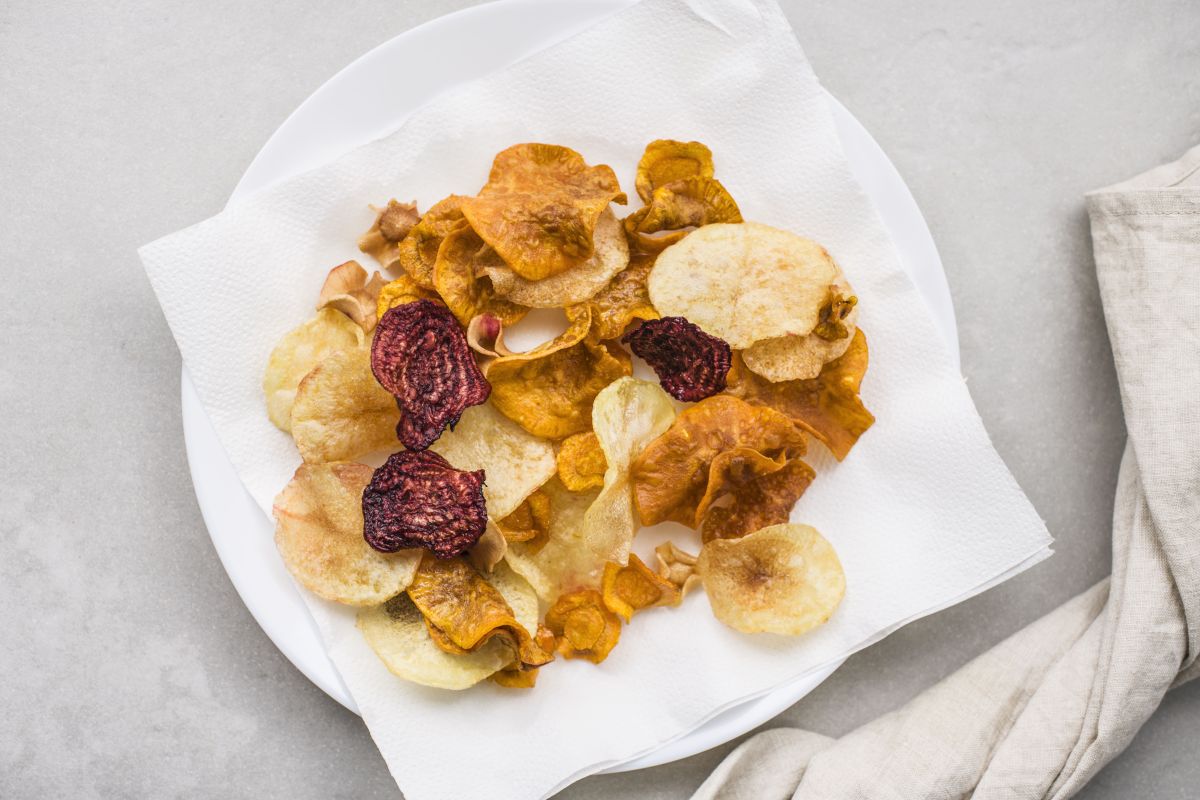Imagine vibrant, crunchy veggie chips bursting with flavor, a testament to nature’s bounty. Forget greasy, processed snacks; this guide unveils the secrets to crafting your own raw vegan veggie chips, a healthy and delicious alternative. We’ll journey through ingredient selection, exploring the nutritional powerhouses that become your chips, from the earthy sweetness of beets to the peppery bite of radishes. Prepare to master dehydration techniques, transforming humble vegetables into satisfyingly crisp delights. Get ready to experiment with tantalizing seasonings, creating flavor combinations that dance on your palate.
This comprehensive guide provides a step-by-step approach, covering everything from meticulous vegetable preparation to achieving the perfect level of crispness. Learn how to select the ideal vegetables, optimize dehydration methods, and create your signature seasoning blends. We’ll also explore creative serving suggestions and storage tips to ensure your chips remain delightfully crunchy and fresh. Get ready to embark on a culinary adventure, transforming simple vegetables into extraordinary snacks.
Flavor Enhancements & Seasoning

Transforming your raw vegan veggie chips from simply healthy to utterly delicious hinges on the art of seasoning. The right blend can elevate even the simplest vegetable into a flavor explosion, creating a complex tapestry of tastes that will keep you coming back for more. Think beyond salt and pepper; the world of spices and herbs offers endless possibilities for culinary creativity.
Savory, Spicy, and Sweet Seasoning Blends for Raw Vegan Veggie Chips
A variety of flavor profiles cater to diverse palates. Savory blends offer earthy and umami notes, while spicy options provide a fiery kick, and sweet seasonings add a touch of natural sweetness. Experimentation is key to discovering your personal favorites.
- Savory: Imagine a blend of nutritional yeast (for cheesy notes), garlic powder, onion powder, and a hint of smoked paprika. This combination creates a rich, savory flavor profile that complements root vegetables like carrots and beets beautifully.
- Spicy: For a fiery twist, combine chili powder, cumin, smoked paprika, and a pinch of cayenne pepper. This blend adds a vibrant heat that pairs perfectly with hearty vegetables such as sweet potatoes and parsnips.
- Sweet: A touch of sweetness can balance savory elements. Consider a blend of cinnamon, nutmeg, and a hint of maple syrup (or other liquid sweetener). This blend works wonders with sweeter vegetables like zucchini and butternut squash, adding warmth and depth.
Recipe: Mediterranean Sunshine Seasoning Blend
This unique blend combines the bright, fresh flavors of the Mediterranean with a hint of warmth.
- Ingredients: 2 tablespoons dried oregano, 1 tablespoon dried basil, 1 tablespoon dried thyme, 1 teaspoon garlic powder, 1 teaspoon onion powder, ½ teaspoon sea salt, ¼ teaspoon black pepper, 2 tablespoons olive oil.
- Preparation: In a small bowl, combine all dry ingredients: oregano, basil, thyme, garlic powder, onion powder, salt, and pepper. Mix thoroughly. Slowly drizzle in the olive oil, stirring constantly until a paste forms. This blend can be stored in an airtight container at room temperature for up to 2 months.
Herbs and Spices that Complement Different Vegetables
The interplay between herbs, spices, and vegetables is a culinary dance. Certain pairings amplify flavors and enhance nutritional benefits.
| Vegetable | Complementary Herbs & Spices | Flavor Interaction & Health Benefits |
|---|---|---|
| Carrots | Cumin, coriander, ginger | Earthy, warm flavors; anti-inflammatory properties from ginger and antioxidants from cumin and coriander. |
| Beets | Rosemary, thyme, black pepper | Earthy, slightly sweet flavors; rosemary’s antioxidant properties and thyme’s potential immune-boosting benefits. |
| Zucchini | Dill, parsley, lemon zest | Bright, fresh flavors; vitamin C from parsley and dill’s potential anti-inflammatory effects. |
| Sweet Potatoes | Cinnamon, nutmeg, cloves | Warm, sweet flavors; antioxidant properties from cinnamon and nutmeg. |
Recipe & Step-by-Step Guide
Creating vibrant, crispy raw vegan veggie chips is easier than you might think! This recipe provides a delicious and healthy snack, perfect for satisfying your cravings while maintaining a plant-based lifestyle. The key is careful preparation and even dehydration to achieve that perfect crunch.
This recipe yields approximately 4-6 servings, depending on the thickness of your slices and the size of your dehydrator. Adjust quantities based on your needs and the size of your vegetables.
Recipe Ingredients
To achieve the best results, select firm, fresh vegetables. Avoid vegetables that are overly ripe or bruised, as these may not dehydrate evenly. The precise measurements can be adjusted to your preference.
- 1 medium beet, thinly sliced (approximately 1/4 inch thick)
- 1 medium carrot, thinly sliced (approximately 1/4 inch thick)
- 1 medium zucchini, thinly sliced (approximately 1/4 inch thick)
- 1/2 cup raw sunflower seeds
- 2 tablespoons nutritional yeast
- 1 tablespoon garlic powder
- 1 teaspoon onion powder
- 1/2 teaspoon sea salt
- 1/4 teaspoon black pepper
- Optional: 1/4 teaspoon smoked paprika for added depth of flavor
Step-by-Step Dehydration Process
Precise slicing and even spacing are crucial for optimal dehydration. Thick slices will take longer to dry and may become chewy instead of crispy. Thinner slices ensure even dehydration and a superior texture.
- Vegetable Preparation: Wash and thoroughly dry all vegetables. Using a mandoline slicer or a very sharp knife, slice the beets, carrots, and zucchini into uniformly thin (1/4 inch) slices. A mandoline ensures consistency, resulting in even dehydration.
- Seasoning Blend: In a small bowl, combine the sunflower seeds, nutritional yeast, garlic powder, onion powder, sea salt, black pepper, and optional smoked paprika. Mix thoroughly to create a flavorful coating.
- Coating the Vegetables: Gently toss the sliced vegetables with the seasoning blend, ensuring each slice is evenly coated. Avoid overcrowding the bowl, allowing for even distribution of the seasoning.
- Dehydrator Arrangement: Arrange the seasoned vegetable slices in a single layer on the dehydrator trays, ensuring that they do not overlap. Proper spacing allows for even air circulation and prevents sticking. A visual representation would show the neatly arranged slices on the dehydrator trays, with ample space between them. This image would highlight the importance of even spacing for optimal dehydration.
- Dehydration: Dehydrate at a temperature of 115°F (46°C) for 6-12 hours, or until the chips are completely dry and crispy. Drying time depends on the thickness of the slices, humidity, and the specific dehydrator model. Regularly check the chips for dryness. The image would show the dehydrator in operation, with the trays neatly stacked and the temperature display visible.
- Cooling and Storage: Once dehydrated, remove the chips from the dehydrator and allow them to cool completely. Store in an airtight container in a cool, dry place for up to 2 weeks. A final image would show the finished, crispy chips arranged attractively in a storage container.
Troubleshooting Common Issues
Addressing common problems proactively will ensure consistently successful results. These tips are based on practical experience and aim to help prevent common dehydration pitfalls.
- Uneven Drying: Ensure even spacing of the slices on the dehydrator trays and rotate the trays halfway through the drying process. This prevents some slices from drying faster than others.
- Sticking to Trays: Use parchment paper or silicone sheets on the dehydrator trays to prevent sticking. This is especially important for vegetables that are naturally sticky, such as beets.
- Chewy Chips: If the chips are chewy, they were not dehydrated long enough. Return them to the dehydrator for a longer period, checking frequently for dryness.
- Burning: If the chips are burning, the dehydrator temperature is set too high. Lower the temperature and monitor closely.
Creating raw vegan veggie chips is more than just a recipe; it’s a journey into mindful snacking and culinary creativity. By following this guide, you’ve unlocked the ability to craft healthy, flavorful chips tailored to your preferences. From the careful selection of vibrant vegetables to the artful application of seasonings, each step contributes to the final satisfying crunch. Experiment with different vegetables and seasonings, discover your favorite combinations, and share your creations with friends and family. Embrace the joy of healthy snacking and savor the delicious rewards of your homemade raw vegan veggie chips.
FAQ Insights
Can I use any vegetable for these chips?
While many vegetables work well, some are better suited than others. Avoid vegetables with high water content that might become mushy during dehydration, such as cucumbers or tomatoes.
How long do the chips last?
Properly stored in an airtight container in a cool, dry place, your raw vegan veggie chips can last for several weeks, retaining their crispness and flavor.
What if my chips are not drying evenly?
Ensure even spacing on your dehydrator trays, and consider flipping the chips halfway through the dehydration process. If using an oven, rotate the baking sheets for even heat distribution.
Can I add nuts or seeds to my seasoning blends?
Absolutely! Adding finely chopped nuts or seeds can add extra texture and flavor to your chips. Consider toasted sesame seeds, chopped almonds, or sunflower seeds.


